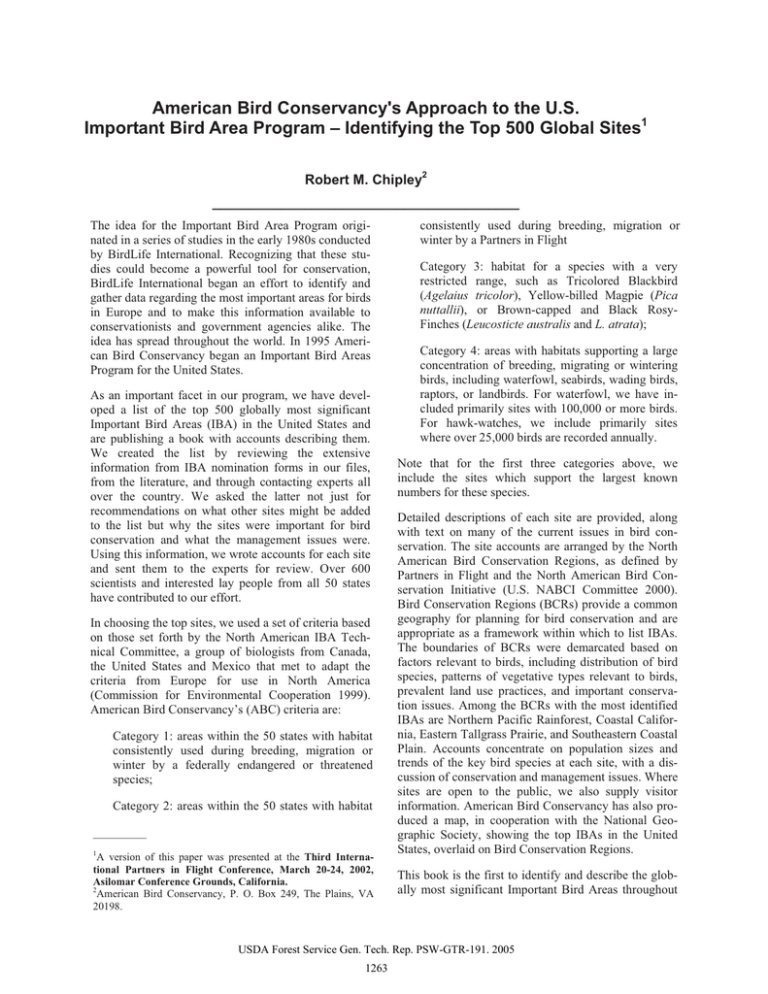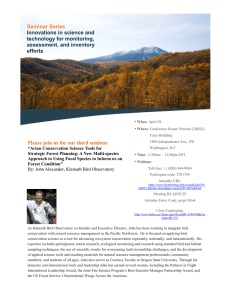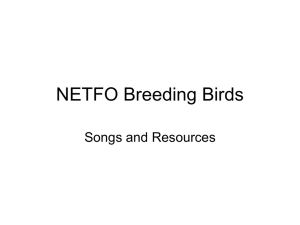American Bird Conservancy's Approach to the U.S.
advertisement

American Bird Conservancy's Approach to the U.S. Important Bird Area Program – Identifying the Top 500 Global Sites1 Robert M. Chipley2 ________________________________________ The idea for the Important Bird Area Program originated in a series of studies in the early 1980s conducted by BirdLife International. Recognizing that these studies could become a powerful tool for conservation, BirdLife International began an effort to identify and gather data regarding the most important areas for birds in Europe and to make this information available to conservationists and government agencies alike. The idea has spread throughout the world. In 1995 American Bird Conservancy began an Important Bird Areas Program for the United States. As an important facet in our program, we have developed a list of the top 500 globally most significant Important Bird Areas (IBA) in the United States and are publishing a book with accounts describing them. We created the list by reviewing the extensive information from IBA nomination forms in our files, from the literature, and through contacting experts all over the country. We asked the latter not just for recommendations on what other sites might be added to the list but why the sites were important for bird conservation and what the management issues were. Using this information, we wrote accounts for each site and sent them to the experts for review. Over 600 scientists and interested lay people from all 50 states have contributed to our effort. In choosing the top sites, we used a set of criteria based on those set forth by the North American IBA Technical Committee, a group of biologists from Canada, the United States and Mexico that met to adapt the criteria from Europe for use in North America (Commission for Environmental Cooperation 1999). American Bird Conservancy’s (ABC) criteria are: Category 1: areas within the 50 states with habitat consistently used during breeding, migration or winter by a federally endangered or threatened species; Category 2: areas within the 50 states with habitat __________ 1 A version of this paper was presented at the Third International Partners in Flight Conference, March 20-24, 2002, Asilomar Conference Grounds, California. 2 American Bird Conservancy, P. O. Box 249, The Plains, VA 20198. consistently used during breeding, migration or winter by a Partners in Flight Category 3: habitat for a species with a very restricted range, such as Tricolored Blackbird (Agelaius tricolor), Yellow-billed Magpie (Pica nuttallii), or Brown-capped and Black RosyFinches (Leucosticte australis and L. atrata); Category 4: areas with habitats supporting a large concentration of breeding, migrating or wintering birds, including waterfowl, seabirds, wading birds, raptors, or landbirds. For waterfowl, we have included primarily sites with 100,000 or more birds. For hawk-watches, we include primarily sites where over 25,000 birds are recorded annually. Note that for the first three categories above, we include the sites which support the largest known numbers for these species. Detailed descriptions of each site are provided, along with text on many of the current issues in bird conservation. The site accounts are arranged by the North American Bird Conservation Regions, as defined by Partners in Flight and the North American Bird Conservation Initiative (U.S. NABCI Committee 2000). Bird Conservation Regions (BCRs) provide a common geography for planning for bird conservation and are appropriate as a framework within which to list IBAs. The boundaries of BCRs were demarcated based on factors relevant to birds, including distribution of bird species, patterns of vegetative types relevant to birds, prevalent land use practices, and important conservation issues. Among the BCRs with the most identified IBAs are Northern Pacific Rainforest, Coastal California, Eastern Tallgrass Prairie, and Southeastern Coastal Plain. Accounts concentrate on population sizes and trends of the key bird species at each site, with a discussion of conservation and management issues. Where sites are open to the public, we also supply visitor information. American Bird Conservancy has also produced a map, in cooperation with the National Geographic Society, showing the top IBAs in the United States, overlaid on Bird Conservation Regions. This book is the first to identify and describe the globally most significant Important Bird Areas throughout USDA Forest Service Gen. Tech. Rep. PSW-GTR-191. 2005 1263 American Bird Conservancy's Approach to the US IBA Program ņ Chipley the country. No single work to date has put the most important sites in the United States into the context of their global meaning to bird conservation. As such it serves both a conservation and educational function. Every birder knows how important Aransas National Wildlife Refuge is to the Whooping Crane (Grus americana) (Lewis 1995), and most know how important Delaware Bay and Grays Harbor (Harrington et al. 1989, MacRae 1995, U.S. Fish and Wildlife Service 1996) are to migrating shorebirds, but less well known is the fact that Apalachicola National Forest has the world’s largest population of Red-cockaded Woodpecker (Picoides borealis) (Costa, pers. comm.), that Fort Hood is number one both for the endangered Golden-cheeked Warbler (Dendroica chrysoparia) and Black-capped Vireo (Vireo atricapillus) (Cornelius, pers. comm.), that Frozen Head State Natural Area in Tennessee has one of the largest known concentrations of Cerulean Warblers (Dendroica cerulea) (T. Ettel, pers. comm.), or that Superior National Forest, Minnesota has the greatest number of breeding species of any national forest, including 24 species of warblers (American Birding Association 1994). Our goal in the program is to sharpen awareness of the public, managing agencies and landowners as to each site’s exceptional value, and to use this heightened recognition to help mobilize the resources to ensure adequate protection. It is an inescapable conclusion that, while protecting more land and setting up more preserves for birds is important, proper management of the existing protected important areas also is critical. One benefit is that an IBA can become a point of pride to the local community. With funds from the Disney Foundation, ABC sent signs and certificates to the top IBAs, naming them of global importance for bird conservation. The signs and certificates have been very well received by the site managers and owners, several sites have held dedication ceremonies, and there are already indications that this increased recognition is helping to allocate more funds for management to benefit birds. Most of the sites in this book are on protected lands. Of the 546 sites mentioned, some 60.4 percent are in federal ownership, 27.7 percent are owned by state governments, 6.2 percent are owned and managed by The Nature Conservancy, 3.1 percent by other conservation groups, 1 percent by municipalities, but only 1.6 percent are on private lands; among the sites with complete or part ownership by private landowners are Cross Bar Ranch, Florida, Upper St. John River Project, Maine, and Butterbredt Spring, California. Does this reflect the true situation in the United States—that for IBAs, public and conservation lands have everything and private lands next to nothing? This undoubtedly is not the case. Then why aren’t private lands better represented? The main reason is that, in general, far less information on birds—both species and numbers—is available on private than on public lands. Most private lands are not open to researchers, let alone the public, and often the level of their significance has not been evaluated. In addition, the rights of property owners are a sensitive issue, and many landowners might regard the naming of their holdings as IBAs with suspicion. We hope that in the future, more private lands might be identified as Important Bird Areas, and that landowners might come to regard this recognition as an object of pride. This is a top priority in the further development of the IBA concept. We thank our two principal partners in the IBA program. The first is The Nature Conservancy, which provided financial support through its Wings of the Americas program, and which has been very helpful in supplying information about the more than 30 of its projects which are IBAs. The second is the Disney Foundation, which supported our project to send signs and certificates to the top 500 sites, naming them and dedicating them as global IBAs. Literature Cited American Birding Association. 1994. Birdfinding in Forty National Forests and Grasslands. Colorado Springs, CO: American Birding Association. Chipley, R. M., G. H. Fenwick, and M. J. Parr. (In press). Where the birds are: America’s top 500 Important Bird Areas. New York,NY: Random House. Commission for Environmental Cooperation. 1999. North American Important Bird Areas. Montreal, Canada: Commission for Environmental Cooperation. Harrington, B. A., J. P. Myers, and J. S. Grear. 1989. Coastal refueling sites for global bird migrants. Proceedings of a Symposium on Coastal and Ocean Management. 6th American Society of Civil Engineers. New York. Lewis, J. C. 1995. Whooping Crane. In: A. Poole and F. Gill, editors. The Birds of North America, No. 153. Philadelphia, PA and Washington, DC: The Academy of Natural Sciences, and The American Ornithologists’ Union. MacRae, D. 1995. Birder’s guide to Washington. Houston, TX: Gulf Publishing Co. U.S. Fish and Wildlife Service. 1996. Management and development plan: Grays Harbor National Wildlife Refuge. Unpublished report. Fish and Wildlife Service, U.S. Department of the Interior. U.S. NABCI Committee. 2000. North American Bird Conservation Initiative. Arlington, VA: North American Bird Conservation Initiative, Fish and Wildlife Service, U.S. Department of the Interior. USDA Forest Service Gen. Tech. Rep. PSW-GTR-191. 2005 1264


